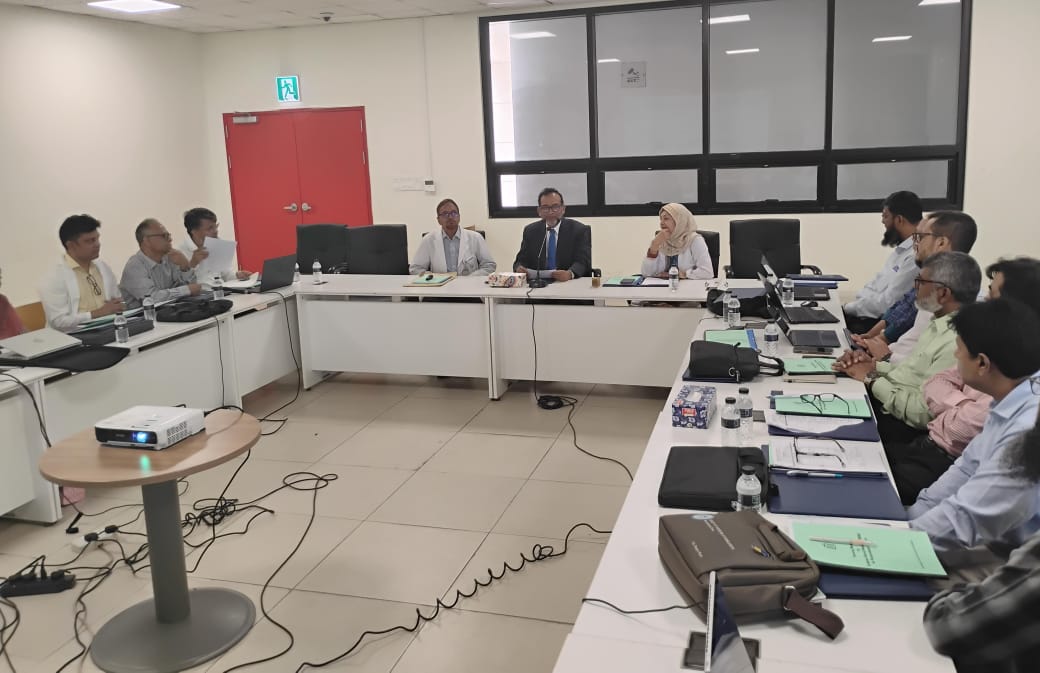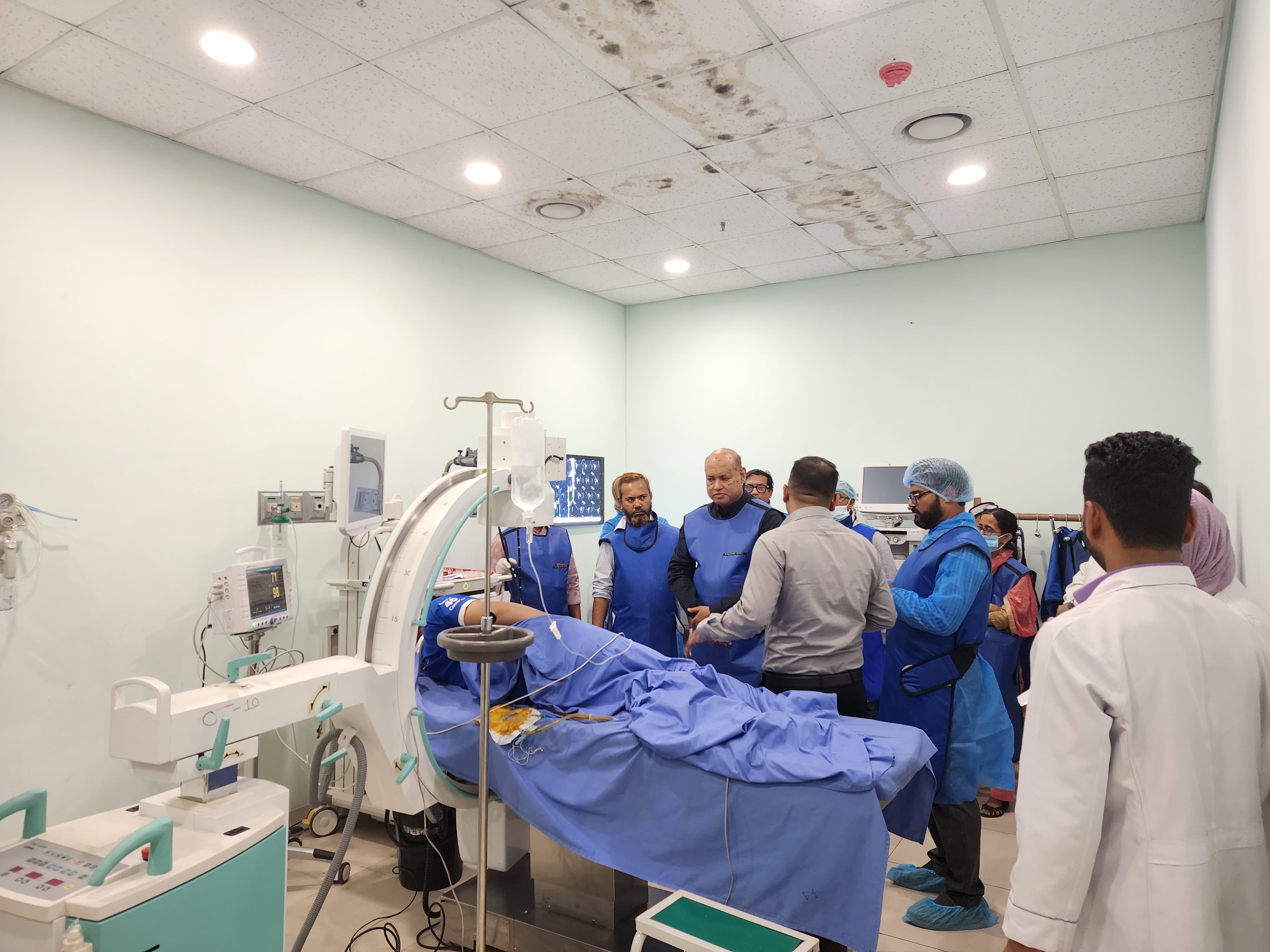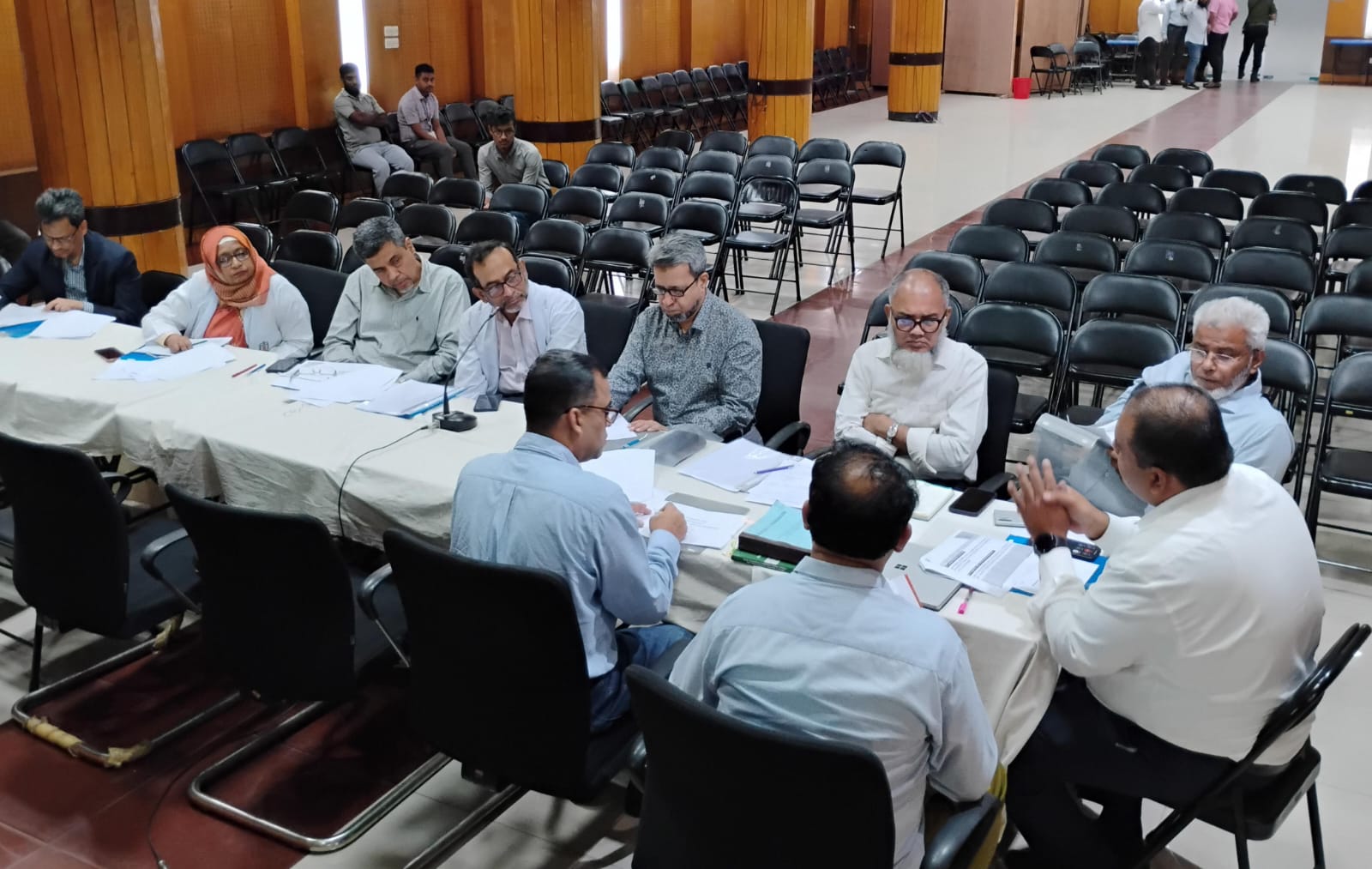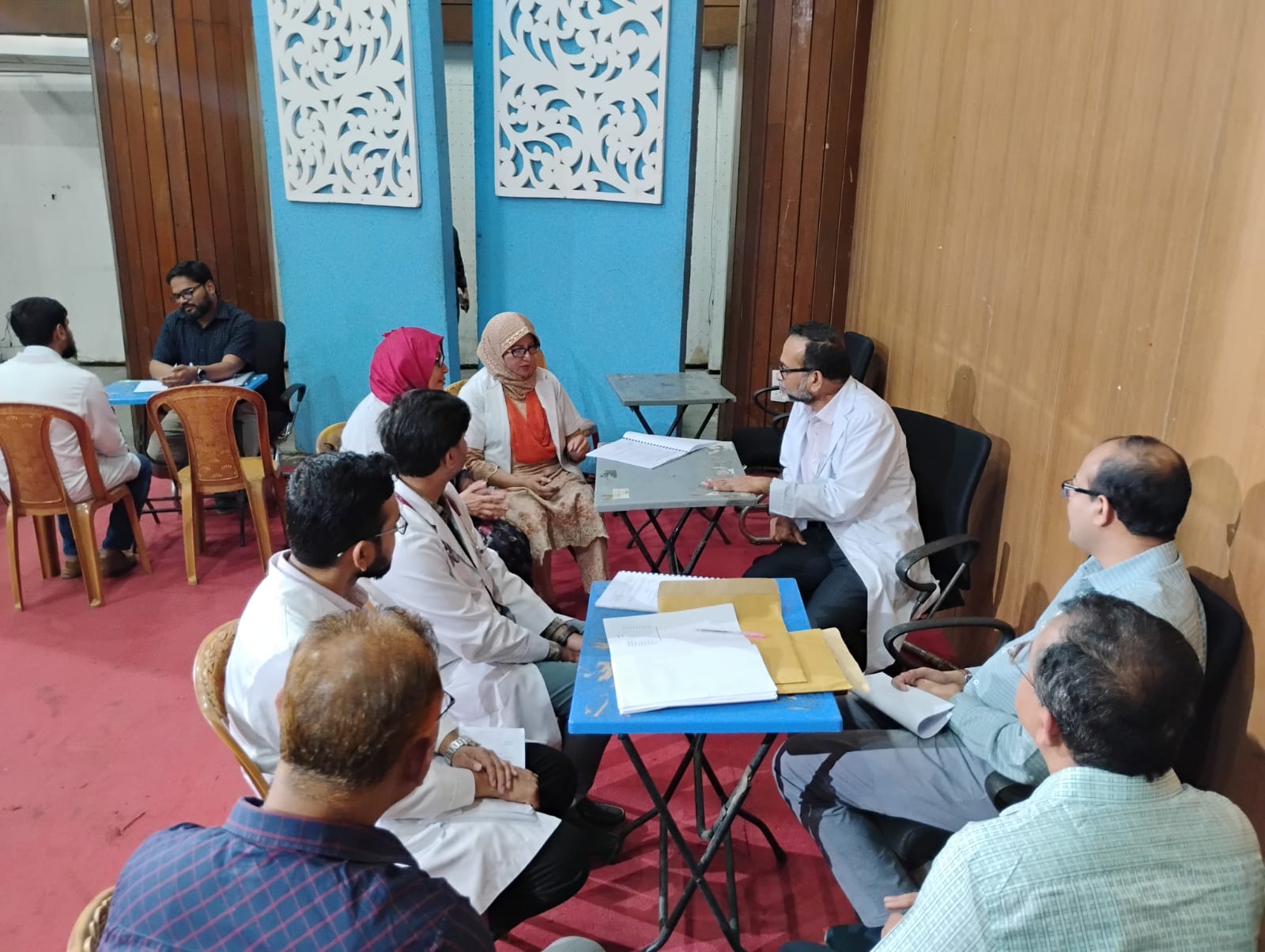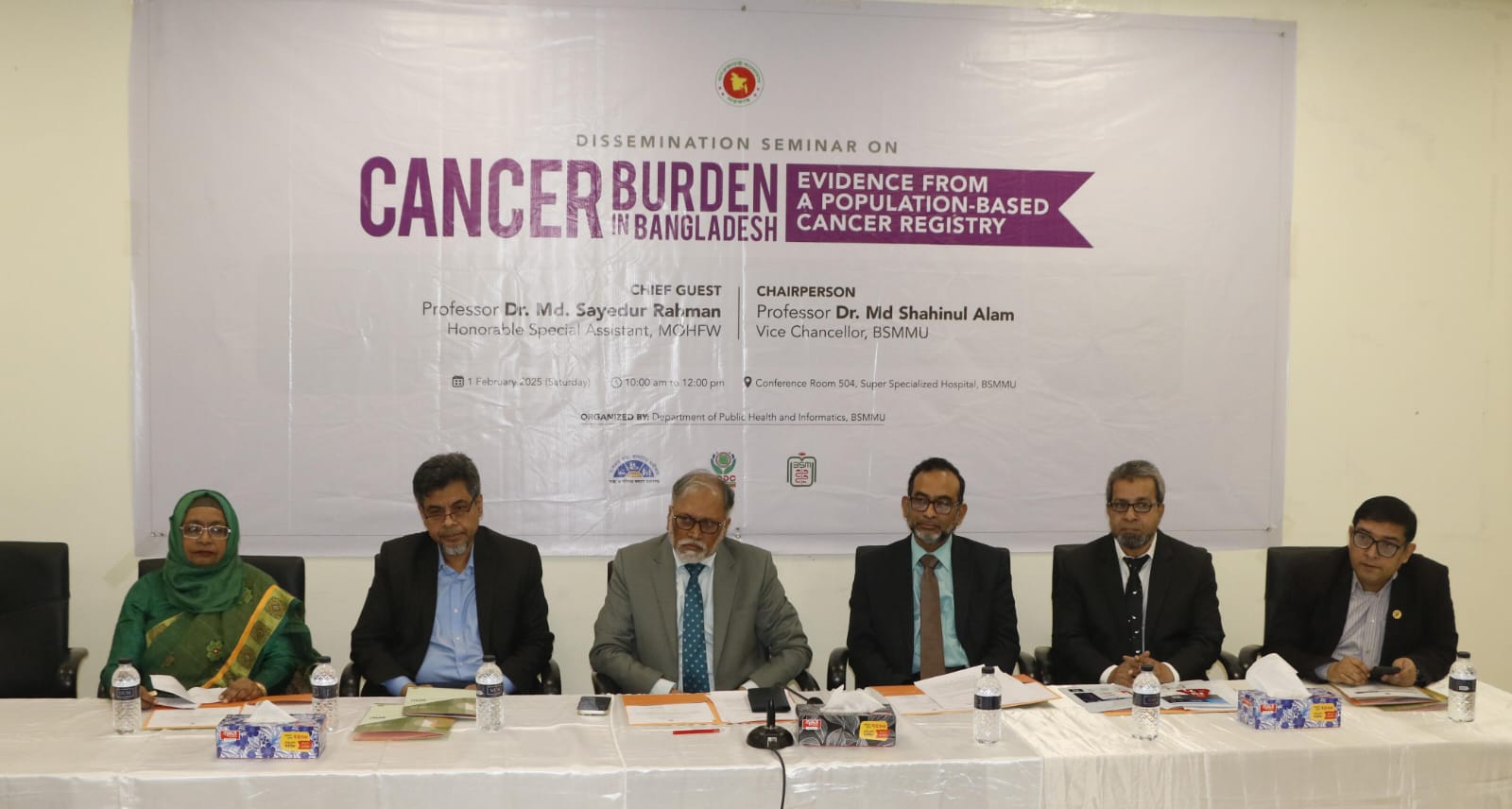
BSMMU Publishes Results of Extensive Research on the Cancer Situation in Bangladesh Based on Population Data
01 Feb, 2025 10:00 AM - 01 Feb, 2025 12:00 PM |
BSMMU Publishes Results of Extensive Research on the Cancer Situation in Bangladesh Based on Population Data
The number of cancer patients per one lakh people in the country is 106, with 53 new cases every year.
Among 38 types of cancer, the highest number of patients are found in breast, mouth, stomach, esophagus, and cervical cancers.
Cancer patients account for 12% of total deaths.
An extensive study on the overall cancer situation in Bangladesh based on population data has been published by BSMMU. The results were revealed on Saturday, February 1, 2025, at a ceremony held in the conference room of the Super Specialized Hospital. The event was titled "Cancer Burden in Bangladesh: Evidence from a Population-based Cancer Registry." The chief guest was Professor Dr. Md. Sayedur Rahman, Special Assistant to the Honorable Chief Advisor (Ministerial Rank). The Vice-Chancellor, Professor Dr. Md. Shahinul Alam, presided over the event. Special guests included Professor Dr. Md. Abul Kalam Azad, Pro-Vice-Chancellor (Administration), Professor Dr. Md. Mujibur Rahman Howlader, Pro-Vice-Chancellor (Research and Development), Treasurer Professor Dr. Nahreen Akhtar, and Professor Dr. Syed Zakir Hossain, Line Director, Directorate General of Health Services (DGHS). The welcome speech was delivered by Professor Dr. Md. Atikul Haque, Chairman of the Department of Public Health and Informatics.
Professor Dr. Md. Sayedur Rahman, Special Assistant to the Honorable Chief Advisor (Ministerial Rank), emphasized that research is indispensable for the creation of new knowledge. He added that research at BSMMU should aim to benefit patients. The government will continue to support research that benefits the people and patients of the country.
Professor Dr. Md. Shahinul Alam, Vice-Chancellor, stated that funding for research that fulfills public needs will not face any issues. He highlighted that the data obtained from the population-based cancer registry in Bangladesh will play a significant role in cancer prevention, treatment, and care for cancer patients. Furthermore, the findings will open new avenues for cancer research in Bangladesh.
The chief researcher, Associate Professor Dr. Md. Khalekuzzaman from the Department of Public Health and Informatics, explained that cancer is one of the leading causes of death globally. In Bangladesh, due to the lack of a population-based cancer registry (PBCR), the cancer situation has to be estimated using data from neighboring countries. As a result, there have been limitations in understanding the exact cancer situation in Bangladesh. Therefore, it was necessary to establish a population-based cancer registry for the Bangladeshi population to accurately assess the situation, which is why this research was conducted. He shared that the research began in July 2023 in the Hosenspur area of Kishoreganj. The study used a specially designed internet-based cancer registration software to collect data through interviews at each household. Follow-up visits for the same families began in July 2024.
Dr. Khalekuzzaman shared that the study covered 200,000 people. It found 38 types of cancer in Bangladesh, with 106 cancer patients per one lakh people. Among the patients, 93% were aged between 18 to 75 years, and 2.4% were children. 5.1% of patients were over 75 years old. The five most common cancers were breast, mouth, stomach, esophagus, and cervical cancers. In men, the five most common cancers were esophageal, stomach, lung, mouth, and throat cancers. In women, the five most common cancers were breast, cervical, mouth, thyroid, and ovarian cancers. Among male cancer patients, 75.8% were smokers, and 40.5% used smokeless tobacco, pan, or jarda. Among female cancer patients, 60.6% used smokeless tobacco. 46% of the cancer cases were related to tobacco use. Among cancer patients, 60% received combined treatments (surgery, chemotherapy, and radiotherapy), and 7.4% did not receive any treatment.
Dr. Khalekuzzaman also reported that cancer accounted for 12% of total deaths in the country, with lung, esophageal, and stomach cancers being the leading causes of death. Every year, 53 new cancer patients are diagnosed per one lakh people. Among the new patients, lung, liver, and esophageal cancers are the most common.
Research Results: Initially, 201,668 participants from 46,631 households were included in the study, with 48.4% male and 51.6% female participants. A total of 214 cancer patients were identified, with an incidence rate of 106 per 100,000 people (118 for men and 96 for women). The research found 38 different types of cancer. Of the cancer patients, 92.5% were aged 18-75, 2.4% were under 18, and 5.1% were over 75. The five most common cancers were breast (16.8%), lips and oral cavity (8.4%), stomach (7.0%), throat (7.0%), and cervical (5.1%). In men, throat cancer was the most prevalent (13.0%), followed by stomach (10.4%), lung (8.7%), lips and oral cavity (7.0%), and esophageal cancers (6.1%). In women, breast cancer was the most common (36.4%), followed by cervical cancer (11.1%), lips and oral cavity cancers (10.1%), thyroid (7.1%), and ovarian cancer (5.1%). Among female cancer patients, 19% had cancers of the female reproductive system (11% cervical, 5% ovarian, and 3% uterine). Co-morbidities among cancer patients included hypertension (17%), diabetes (11%), heart disease (6%), chronic kidney disease (3%), and stroke (2%). Among male cancer patients, 75.8% were smokers, and 40.5% used smokeless tobacco products. Among female cancer patients, 60.6% used smokeless tobacco. A total of 46% of cancers were related to tobacco use (both smoking and smokeless). 60% of cancer patients received combined treatments (surgery, chemotherapy, and radiotherapy), while 7.4% received no treatment.
Follow-up: From July 1, 2024, to January 14, 2025, 13,411 households with 58,539 participants were followed up. Over the course of one year, the number of new cancer patients increased by 52.9 per 100,000. The three most common new cancers were lung (16.1%), liver (12.9%), and throat (12.9%). Among men, the three most common new cancers were lung (16.1%), liver (12.9%), and laryngeal cancer (12.9%). Among women, the most common new cancers were liver (23.1%), cervical (15.4%), and esophageal (15.4%) cancers. Cancer accounted for 11.9% of all deaths, with lung cancer (11.4%), laryngeal cancer (8.5%), and stomach cancer (5.7%) being the leading causes of death. In men, the top two causes of death were lung (19.0%) and laryngeal cancer (14.3%), while in women, breast cancer (14.3%) and stomach cancer (14.3%) were the leading causes.
The event concluded with recommendations for the continuation of the population-based cancer registry and for researchers to be encouraged to conduct future cancer studies using the current registry. The study was funded by the National Cancer Control Program (NCDC), DGHS, and BSMMU.
Edited by: Dr. Saiful Azam Ronju
Photos: Arif Khan
News: Prosunto Mazumder

